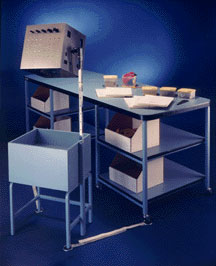
Purpose: The CUBE is a multi-purpose battery of exercises designed to assess various skills and abilities that are used to compensate for loss of vision by the visually impaired and blind. Assessed skills are relevant to both daily living and vocational situations. These skills range from spatial aptitude and motor coordination, to problem-solving skills, and tactile and auditory perceptual abilities. The work sample establishes baseline measures which may be compared to scores after orientation and mobility training and rehabilitation teaching to gauge progress toward established client goals.
The work sample may also be used as a teaching aid, and is appropriate for various work-hardening purposes.
Design: The CUBE is a series of hands-on exercises that are divided into five main parts. Exercises within each part progress from relatively simple to more complex or difficult.
Special Features: A supplied blindfold may be used with clients with residual vision to isolate and assess and/or enhance the client’s remaining perceptual abilities. This approach is particularly suited to those whose visual loss is due to a progressive disease or condition, and who must therefore learn to rely on alternative perceptual skills.
Information Collected: The exercises come with standardized instructions and produce both time and point scores. These may be compared to local norms, if desired. (BASES will offer assistance to users who wish to develop such norms.)
Objective baseline measures (scores) may be compared to post-training scores to index client progress.
The exercises all afford the opportunity to make behavioral observations relevant to a number of work related client characteristics, such as frustration tolerance, self- confidence, etc. Such observations can be used for counseling and other rehabilitation purposes.
Finally, the user may make estimates of various aptitudes and other work-related factors based on scores and observations, as these factors have been defined in U.S. Department of Labor’s Revised Handbook for Analyzing Jobs (1991) and Dictionary of Occupational Titles (4th ed., rev. 1991). Such estimates are used in occupational exploration with appropriate clients.
Organization:
CUBE begins with a general orientation to familiarize the client with the defined work area and the work sample parts and layout.
Part One: Tactual Perception. Clients work with various blocks and other parts in eight exercises of increasing difficulty that involve discrimination between rough and smooth objects, between various geometrical shapes; and tactual discrimination from verbal cues.
Part Two: Mobility/Discrimination Skills. Clients perform ten exercises in which they discriminate sizes, weights, textures, and discern physical similarities while working and moving within a limited work space.
Part Three: Spatial Organization and Memory. Four exercises require the client to visualize, organize, and remember shape configurations as they rotate from one plane to another. The client reproduces shapes from a side panel of CUBE to the top panel.
Part Four: Assembly and Packaging. Seven vocational exercises begin at a simple level and become increasingly complex until, in the final task, the client completes the wiring for an electrical assembly.
Part Five: Audile Perception. Six exercises assess the client’s ability to identify the changing locations of sounds, to identify various common sounds, and to comprehend and recall three conversations that occur simultaneously.
Components:
The CUBE is a stainless steel cube measuring 11″. It attaches to a three-piece pedestal mounted in a box below. The pedestal is adjustable so the cube can be raised or lowered to accommodate standing or seated clients. An allen wrench is included for adjusting the rotation tension of the cube. (Table not included.)
The inventory of the CUBE consists of more than 175 pieces, including the hardware, scoring materials, and manual.
Shipping Size and Weight: (2 Boxes) 24″ x 24″ x 18″ @ 47lbs; 20″ x 24″ x 18″ @ 50lbs
